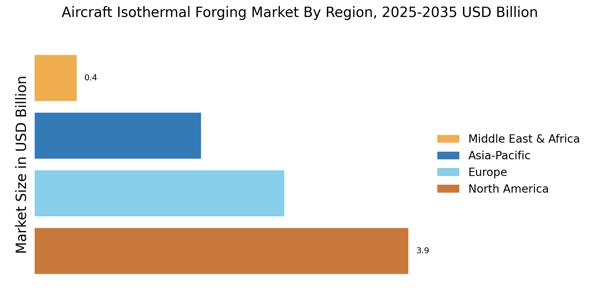Rising Demand for Lightweight Materials
The Aircraft Isothermal Forging Market is experiencing a notable increase in demand for lightweight materials, driven by the aviation sector's need for fuel efficiency and performance enhancement. As manufacturers seek to reduce aircraft weight, isothermal forging emerges as a preferred method for producing high-strength components from lightweight alloys. This trend is underscored by data indicating that the aerospace industry aims to achieve a 20% reduction in fuel consumption by 2030. Consequently, the adoption of isothermal forging techniques is likely to rise, as they facilitate the creation of complex geometries while maintaining material integrity. The growing emphasis on lightweight materials is expected to propel the Aircraft Isothermal Forging Market forward, as companies invest in advanced manufacturing processes to meet these evolving demands.
Increased Investment in Aerospace Sector
The Aircraft Isothermal Forging Market is benefiting from heightened investment in the aerospace sector, which is projected to reach USD 1 trillion by 2030. This influx of capital is primarily directed towards research and development, infrastructure expansion, and the adoption of advanced manufacturing technologies. As aerospace companies strive to enhance their production capabilities, isothermal forging is increasingly recognized for its ability to produce high-performance components with superior mechanical properties. The financial commitment to innovation and efficiency in the aerospace industry suggests a robust growth trajectory for the Aircraft Isothermal Forging Market, as manufacturers seek to leverage these advanced techniques to improve product quality and reduce production costs.
Regulatory Compliance and Safety Standards
The Aircraft Isothermal Forging Market is significantly influenced by stringent regulatory compliance and safety standards imposed by aviation authorities. These regulations necessitate the use of high-quality materials and manufacturing processes that ensure the safety and reliability of aircraft components. Isothermal forging, known for its ability to produce components with enhanced mechanical properties, aligns well with these requirements. As regulatory bodies continue to enforce rigorous safety protocols, the demand for isothermal forged components is likely to increase. This trend indicates a growing reliance on advanced manufacturing techniques within the Aircraft Isothermal Forging Market, as companies strive to meet compliance while maintaining competitive advantages.
Growing Focus on Sustainable Manufacturing Practices
The Aircraft Isothermal Forging Market is increasingly aligning with the global shift towards sustainable manufacturing practices. As environmental concerns gain prominence, aerospace manufacturers are seeking methods that minimize waste and energy consumption. Isothermal forging, with its ability to produce high-quality components while reducing material waste, presents a viable solution. The industry is projected to see a rise in the adoption of eco-friendly practices, as companies aim to meet sustainability targets and enhance their corporate social responsibility profiles. This growing focus on sustainability is expected to drive demand within the Aircraft Isothermal Forging Market, as manufacturers prioritize environmentally responsible production methods.
Technological Innovations in Manufacturing Processes
The Aircraft Isothermal Forging Market is witnessing a surge in technological innovations that enhance manufacturing processes. Advancements in automation, computer-aided design, and simulation technologies are streamlining isothermal forging operations, resulting in improved efficiency and reduced lead times. These innovations enable manufacturers to produce complex geometries with precision, thereby expanding the application scope of isothermal forging in the aerospace sector. As technology continues to evolve, the Aircraft Isothermal Forging Market is likely to experience increased adoption of these advanced techniques, which could lead to higher production rates and lower operational costs, ultimately benefiting the entire supply chain.


















Leave a Comment